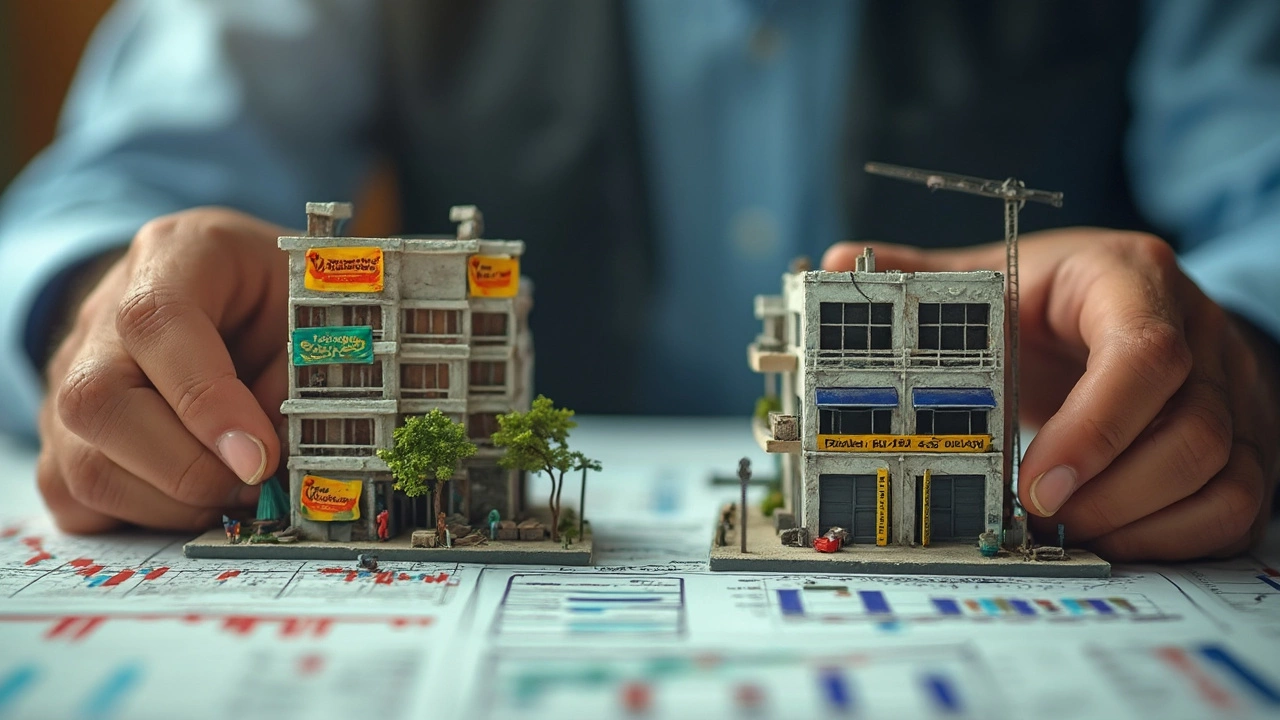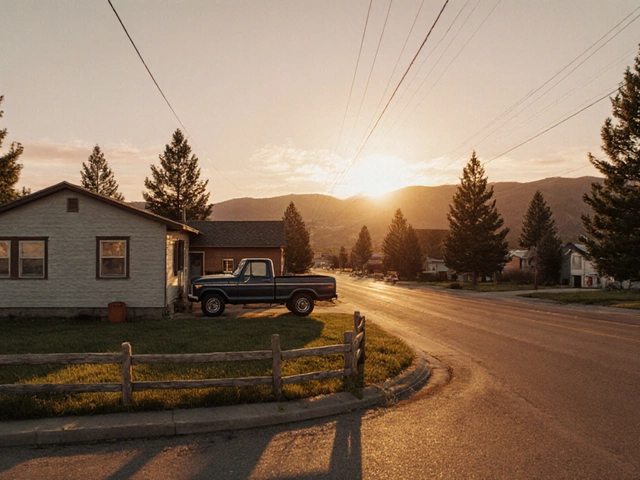If you think all commercial properties play by the same rules, think again. Not everything with a "For Sale" sign promises equal safety—some types are basically a minefield if you're not careful. Risk comes from more than just a sketchy tenant or a bad neighborhood. It hides in changes to shopping trends, boring vacancies, and even the fine print in your lease agreements.
A plain fact: retail properties, like aging strip malls and big-box stores, often top the list as the riskiest asset class. Why? Blame the online shopping boom. More people are clicking 'buy now' instead of heading to brick-and-mortar stores, which means landlords can lose tenants fast and have trouble filling empty spaces. When malls lose an anchor tenant, rent collections drop and so does the building’s value. If you don't have deep pockets, this can turn ugly in a flash.
It's not just retail in the hot seat. Office buildings, especially outdated ones in slow-growth areas, can also be a risky bet. Companies keep shrinking their floor space, leaving owners with empty desks and unpaid utility bills. Plus, when the market tanks, these places can sit empty for years, costing tons in maintenance and taxes.
- Spotting High-Risk Asset Classes in Commercial Property
- Why Certain Sectors Are Riskier Than Others
- Pitfalls Most Investors Overlook
- How to Reduce Your Exposure to Risk
Spotting High-Risk Asset Classes in Commercial Property
Not all commercial property is built the same. Some types throw up red flags faster than others. If you’re looking to spot a truly high-risk asset, there are a few usual suspects always popping up in the headlines and market reports. The main three? Retail, office, and certain segments of hospitality.
Let’s break down why:
- Retail Properties: Strip malls, regional shopping centers, and standalone big-box stores are under pressure. Online shopping is draining foot traffic, and many brands are closing locations. Vacancy rates in U.S. retail hit 4.9% in 2024—the highest in eight years.
- Office Space: Demand for traditional office buildings is sagging. Remote work isn’t a passing trend, and tenants want flexible leases or smaller footprints. As of late 2023, over 18% of U.S. office space sat empty, especially in areas that depend on big businesses or tech companies.
- Hospitality: Hotels tied to business travel and conventions are risky, especially if they’re not in tourist hotspots. These properties saw average occupancy drop almost 30% during recent travel slowdowns.
Here’s a side-by-side look at recent vacancy rates for commercial assets, just to highlight where the biggest risks appear:
| Asset Class | Average Vacancy Rate (2024) |
|---|---|
| Office | 18.2% |
| Retail | 4.9% |
| Industrial | 3.6% |
| Multifamily (Apartments) | 6.7% |
| Hospitality (Hotels) | ~25% (seasonal) |
So, if you see high vacancy rates and shifting demand, that's your cue a property is riskier than it looks. Dig into the numbers before you make any moves. Pay attention to real estate investment trends, and don’t get fooled by a property that looks shiny from the curb. The riskiest asset classes are clearly the ones with high vacancies and unstable tenants—that’s where your money is most likely to vanish.
Why Certain Sectors Are Riskier Than Others
Not all commercial property is built equal. When talking about the risky asset class in commercial property, you have to look at the forces that hit each sector differently. People like to talk about retail, office, and industrial—but the risk isn’t just about how shiny the building looks. It’s about real shifts in how people work, shop, and live right now.
Retail has struggled big time, mostly because of online shopping. Think about how often you order something to your doorstep these days. That change alone has gutted tons of strip malls and made big-box tenants run for the hills. According to data from Green Street Advisors, mall values in the U.S. have dropped over 20% since 2016. If you own a retail center, tenants might close up shop without much notice, forcing you to scramble for new ones. No one wants a half-empty property dragging their portfolio down.
Next up: office buildings. Remote work isn’t a passing trend—lots of companies have gotten used to smaller spaces or fully remote setups since 2020. In major U.S. cities, vacancy rates for downtown offices shot above 18% in 2024. That’s brutal. If you’ve got an old office building in an area that’s lost its buzz, finding good tenants is like hunting for a unicorn. If a big tenant breaks a lease, you’re left covering hefty expenses with no one to offset the costs.
| Sector | Average Vacancy Rate (2024) | Main Risk Factor |
|---|---|---|
| Retail | 13.7% | Online shopping, tenant closures |
| Office | 18.4% | Remote work, lease defaults |
| Industrial | 6.2% | Supply chain shifts |
Industrial properties (like warehouses) look less risky for now, but even they face trouble when supply chains hit snags or big tenants go bust. Still, when you compare asset classes, retail and office are almost always called out by pros as top contenders for biggest headache.
So, why are certain sectors riskier? It boils down to three main reasons:
- Fast-changing market trends (think e-commerce, remote work)
- Lack of tenant stability—tenants either leave often or shut down for good
- High ongoing costs (maintenance, property taxes) even when there’s no rent coming in
If you’re chasing high returns in risky property sectors, just know the roller coaster can get wild fast.

Pitfalls Most Investors Overlook
Even experienced investors get blindsided by problems in commercial property. It's not always the obvious stuff. Most folks zero in on location and lease terms but skip smaller details that later blow up in their face.
- Underestimating Maintenance Costs: Big buildings look flashy, but everything from roof leaks to busted HVAC systems can shred your budget. A 2023 survey showed that unexpected repairs raise total expenses by 10-20% for many commercial landlords.
- Overlooking Local Market Shifts: National trends matter, but local stuff kills deals even faster. If a major employer leaves town or zoning rules change, your building’s value can tank overnight. Always check city council plans and economic reports, not just current traffic counts.
- Assuming Tenants Will Renew: No, your tenants aren’t glued to the spot. Office and retail tenants often leave sooner than investors expect. In the last two years, renewal rates for shopping center leases dropped from 65% to just 51% in the US, according to CBRE.
- Ignoring Debt Terms: Many jump at low interest rates without realizing loans are often short-term with balloon payments. When time’s up, you could be forced to sell or refinance at way worse rates.
- Forgetting About Technology: Some properties just aren’t wired for modern life. Outdated internet, no EV charging, and energy-guzzling lighting push high-quality tenants away. Upgrades cost money, and the bill is never tiny.
Here’s a look at how these issues stack up for risky asset class properties in commercial real estate:
| Pitfall | Estimated Cost Impact |
|---|---|
| Major Repairs | 10-20%+ of annual cash flow |
| Vacancy Surge | 8-12 months to fill space |
| Loan Recapitalization | Interest rates can jump by 2-4% |
| Tech Upgrades | $10-$25 per sq ft |
What happens if you skip the homework? You might end up buying the right building at the wrong time, or sinking cash into a space nobody wants. Investors who win in commercial property pay attention to these hidden landmines, not just the shiny surface stats.
How to Reduce Your Exposure to Risk
Jumping into commercial property can feel like gambling, but you don't have to let risk rule your wallet. Real estate pros don’t just cross their fingers—they manage smart. Here’s how you can nip risk in the bud and protect your investment.
- Spread your bets. Don’t toss all your cash into one property type. If you’re heavy in retail and online sales spike, your portfolio tanks. Mix in industrial or multifamily buildings. They don’t usually react to the same market shocks as retail or office spots.
- Know your tenants. Research who actually pays the rent. National brands with deep pockets are far safer than a one-shop startup. Long-term leases with reliable tenants give you steadier cash flow.
- Track lease expirations. Stagger them instead of having all leases end at once. This way, you’re never stuck with a totally empty building if the market mood shifts.
- Stay ahead on property upgrades. Outdated buildings turn away the best tenants—and empty suites pile up fast. Fix up old energy systems and keep the look modern. Properties that are easy to rent out in any market are way less risky.
- Check the neighborhood’s pulse. Big changes are a red flag. If a new bypass kills local traffic or a big anchor closes, your whole area could lose appeal. Watch for local job numbers, school ratings, and new infrastructure before you buy.
A 2024 CBRE report showed industrial vacancy rates at just 4%, while retail strip mall vacancies were closer to 9%. That’s a world of difference in finding new tenants if someone moves out. Keeping those numbers in mind lets you see which types of commercial property are less risky if things go south.
Finally, make peace with paperwork. Get airtight contracts, solid insurance, and always budget for the “stuff happens” fund. Even pros get blindsided—but you won’t lose sleep if your legal and financial guardrails are strong.





